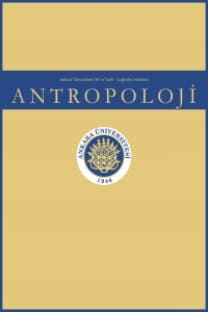Konstantin ve Helena Kilise’sinde (Andaval) Mezar Tiplerinden ve Buluntulardan Sosyal Statünün Belirlenmesi
Konstantin ve Helena Kilisesi, Biyoarkeoloji, Sosyal Statü, Bizans
Determination of Social Status from Grave Types and Grave Goods at Konstantine and Helena Church (Andaval)
___
- Kaynakça
- Acara, M. (1998) “Bizans Ortodoks Kilisesinde Liturji ve Liturjik Eserler”, Hacettepe Üniversitesi Edebiyat Fakültesi Dergisi 15(1):183-201, Ankara.
- Angel, J.L. (1971) "Early Neolithic Skeleton from Çatal Höyük: Demography and Pathology”, Anatolian Studies.
- Buikstra, J. ve Ubelaker D. (1994) Standarts for Data Collections From Human Skeletal Remains, Fayetteville, Achaeological Survey, Akansas.
- Büyükkarakaya, A.M, Erdal, Y.S ve M. Özbek (2009) “Tepecik/Çiftlik İnsanlarının Antropolojik Açıdan Değerlendirilmesi”, 24. Arkeometri Sonuçları Toplantısı, ss:119-138, T.C. Kültür Bakanlığı, Anıtlar ve Müzeler Genel Müdürlüğü, Ankara.
- Çetinkaya, H. (2011) “Roma ve Bizans İmparatorluklarında Ölüm Algısı ve Mezar Türleri”, Mimar Sinan Güzel Sanatlar Üniversitesi Sosyal Bilimler Enstitüsü Dergisi 3:18-39, İstanbul.
- Çevik, N. (2000) Urartu Kaya Mezarları ve Ölü Gömme Gelenekleri, Atatürk Kültür, Dil ve Tarih Yüksek Kurumu Türk Tarih Kurumu Basımevi, VI Dizi- Sayı 58, Ankara.
- Demirci, K. (1993) “Cenaze”, Türk Diyanet Vakfı İslam Ansiklopedisi 7:153, İstanbul.
- Doğanay, O. (2010) “İsauria Bölgesi Ölü Gömme Adetlerine Genel Bir Bakış”, Arkeoloji ve Sanat 133:39-57.
- Donald, M.N. (2003) Bizans’ın Son Yüzyılları (1261-1453), Tarih Vakfı Yurt Yayınları, İstanbul.
- https://tr.instela.com/roliker--784877, (Erişim 31 Ekim 2018).
- İşcan, M.Y. ve S.R. Loth (1989) Reconstruction of Life from the Skeleton, Y.İşcan ve K.A.R. Kennedy (Eds.). Alan R.Liss, Inc., 23-46 New York.
- Karakoç, K. (2018) Osmanlı-Bizans Kroniklerinde Düğün ve Ölüm, Yayımlanmamış Yüksek Lisans Tezi, Tekirdağ Namık Kemal Üniversitesi Sosyal Bilimler Enstitüsü Tarih Anabilim Dalı.
- Kavrakoğlu, F. (2015) blog.kavrakoglu.com/tag/bizansta-olum (Erişim: 19 Ekim 2018)
- Krogman, W. ve M. İşcan (1986) “The Human Skeletal in Forensic Medicine”, (2. Baskı). Springfield C. C. Thomas.
- Kurt, M. (2011) “Karaman-Binbir Kilise Mezarları”, Karamanoğlu Mehmetbey Üniversitesi, Sosyal ve Ekonomi̇k Araştırmalar Dergi̇si 13 (21):125-131, Karaman.
- Lévy-Bruhl, L. (2006) İlkel İnsanda Ruh Anlayışı, (O. Adanır. Çev.). Doğu Batı Yayınları. Ankara.
- Lovejoy, C., Meindl, R., Pryzbeck, T. ve R. Mensforth (1985) Chronogical Metamorphosis of the Auricular Surface of the Ilium: A new Method for the Determination of Adult Skeletal Age at Death”, American Journal of Physical Anhtropology 68:15-28.
- Ötüken, Y. (1987) “Niğde’nin Eski Andaval Köyündeki Helena Konstantinos Kilisesinin Freskoları”, Remzi Oğuz Arık Armağanı, Ankara Üniversitesi Dil ve Tarih-Coğrafya Fakültesi Yayını, 125-145.
- Özbek, M. (1993) “Aşıklı Höyük Neolitik Çağ İnsanaları”, VIII. Arkeometri Sonuçları Toplantısı, ss:201-212. Eski Eserler ve Müzeler Genel Müdürlüğü, Ankara.
- Özbek, M. (1990) “Son Buluntular Işığında Çayönü Neolitik Çağ İnsanları”, V. Arkeometri Sonuçları Toplantısı, ss:161-172. T.C. Kültür Bakanlığı, Anıtlar ve Müzeler Genel Müdürlüğü, Ankara.
- Özbek, M. (1986) “Değirmentepe Eski İnsan Topluluklarının Demografik ve Antropolojik Açıdan Analizi”, I. Arkeometri Sonuçları Toplantısı, ss:107-130. Eski Eserler ve Müzeler Genel Müdürlüğü, Ankara.
- Özkan, E. (1988), “Bizans’ta Sosyal Yaşam”, İlgi Dergisi 22(55):20-24, Mimar Sinan 400. Anma Yılı, İstanbul.
- Özterzi, S. (2011), Anadolu’da Neolitik ve Kalkolitik Dönemdeki Mezar Tiplerini ve Ölü Gömme Geleneklerinin Sosyokültürel Açıdan Değerlendirilmesi, Yayımlanmamış Yüksek Lisans Tezi, A.Ü. Sosyal Bilimler Enstitüsü Antropoloji (Paleoantropoloji) Anabilim Dalı, Ankara.
- Pearson, M.P. (1999) The Archaeology of Death and Bruial, A&M Universty Press, Texas.
- Pekak, M.S. (1998) “Niğde-Andaval (Aktaş)’daki Konstantin-Helena Kilisesi”, VII. Milli Selçuklu Kültür ve Medeniyeti Semineri (II. Ortaçağ ve Türk Dönemi Kazı-Araştırmaları Sempozyumu, 30 Nisan-02 Mayıs 1998). Selçuk Üniversitesi Selçuklu Araştırma Merkezi.
- Rice, T.T. (2002) Bizans’ta Günlük Yaşam, Özne Yayınları, Ankara.
- Robb, J., Biggazi, R., Lazzarini, L., Scarsini, C. ve F. Sonego (2001) “Social “Status” and Biological “Status”: A Comparsion of Grave Goods and Skeletal Indicators From Pontecagnano”, American Journal of Physical Anthropology 115: 213-222.
- Seeher, J. (1993) "Tod und Bestattung in Der Vorgeschicte, Tarih Öncesi Çağlarda Ölüm ve Gömü" , (S. Gülçuri Çev.). Arkeoloji ve Sanat Dergisi 59, İstanbul.
- Sevim, A., Pehlevan, C. ve I. Günay (2006) “Arkeolojide Paleoantropoloji” Hayat Erkanal’a Armağan, Kültürlerin Yansıması, Homer Kitapevi ve Yayıncılık, İstanbul.
- Strygowski, J. (1903) Kleinasien ein Neuland der Kunstgeschichte, Leipzig.
- Ubelaker, D.H. (1978) Human Skeletal Remains: Excavations, Analysis, Interpretation, Aldine Publishing Company, Workshop of European Anthropologist, Chicago.
- Uhri, A. (2014) Anadolu’da Ölümün Tarihöncesi, Bir Geleneğin Oluşum Süreçleri (2. Baskı), Ege Yayınları, İstanbul.
- Uysal, G. (2015) “Konstantin-Helena Kilisesi (Andaval) Paleodemografik Analizi ve Kemik Tüberkülozu”, VI. Ulusal Biyolojik Antropoloji Sempozyumu 26-28 Ekim.
- Workshop Of European Anthropologist (1980) “Recommendations for Age and Sex Diagnoses of Skeletons”, Journal of Human Evolution 9 517-549.
- ISSN: 0378-2891
- Yayın Aralığı: 2
- Başlangıç: 1963
- Yayıncı: Ankara Üniversitesi Basımevi
Türk Kültüründe Bir Korku Kültü Olarak Sivas’ta Alkarısı ve Albasması İnanışı
Laura Esquivel ‘in Acı Çikolata Romanı Üzerinden Duygusal Dünya ve Yemek Kültürü İlişkisi
Pelvis'ten Radyolojik Yöntemler ile Cinsiyet Taiyini: Türkiye Örneklemi
Etnografik Bir Veri Olarak Fotoğraf: Temsil, Düşünümsellik ve Gerçekçilik
Kültür, Gündelik Hayat ve Teatrallik İlişkisi Açısından Performans Antropolojisi
